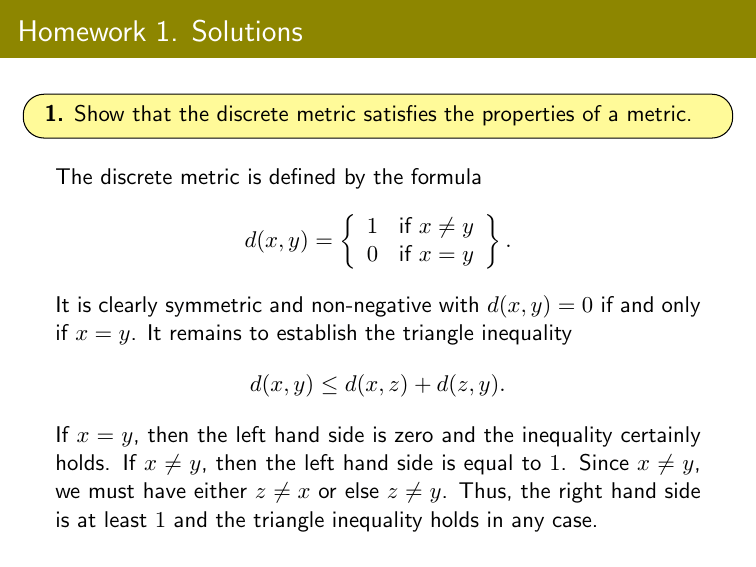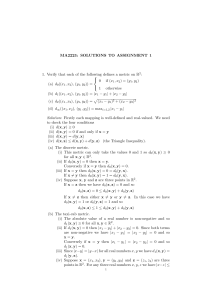Homework 1. Solutions
advertisement

Homework 1. Solutions
1. Show that the discrete metric satisfies the properties of a metric.
The discrete metric is defined by the formula
1 if x 6= y
d(x, y) =
.
0 if x = y
It is clearly symmetric and non-negative with d(x, y) = 0 if and only
if x = y. It remains to establish the triangle inequality
d(x, y) ≤ d(x, z) + d(z, y).
If x = y, then the left hand side is zero and the inequality certainly
holds. If x 6= y, then the left hand side is equal to 1. Since x 6= y,
we must have either z 6= x or else z 6= y. Thus, the right hand side
is at least 1 and the triangle inequality holds in any case.
Homework 1. Solutions
2. Compute the distances d1 (f, g) and d∞ (f, g) when f, g ∈ C[0, 1]
are the functions defined by f (x) = x2 and g(x) = x3 .
Since x2 ≥ x3 for all x ∈ [0, 1], the first distance is given by
d1 (f, g) =
Z
1
x3 x4
−
(x − x ) dx =
3
4
2
0
3
1
=
0
1 1
1
− = .
3 4
12
To compute the second distance, we need to find the maximum of
h(x) = x2 − x3 ,
0 ≤ x ≤ 1.
Since h′ (x) = 2x − 3x2 = x(2 − 3x), it easily follows that
d∞ (f, g) = h(2/3) = 4/9 − 8/27 = 4/27.
Homework 1. Solutions
3. Sketch the open ball B((0, 0), 1) in the metric space (R2 , d∞ ).
The open ball B((0, 0), 1) contains the points (x, y) that satisfy
d∞ ((x, y), (0, 0)) = max{|x|, |y|} < 1.
Now, the maximum of two numbers is smaller than 1 if and only if
the two numbers are both smaller than 1. This gives the condition
|x| < 1 and
|y| < 1.
Thus, the open ball B((0, 0), 1) is the interior of the square whose
vertices are located at the points (±1, ±1).
Homework 1. Solutions
4. Let A = {x ∈ R : x > 0}. Is this set bounded in (R, d) when d is
the usual metric? Is it bounded when d is the discrete metric?
This set is not bounded with respect to the usual metric. If it were
bounded, then we would have
A ⊂ (x − r, x + r)
for some x ∈ R and some r > 0. This is not the case because
|x| + r ∈ A,
|x| + r ∈
/ (x − r, x + r).
To show that A is bounded with respect to the discrete metric, we
note that A is contained in B(x, 2) = R for any x ∈ R.
Homework 1. Solutions
5. Consider a metric space (X, d) whose metric d is discrete. Show
that every subset A ⊂ X is open in X.
Let x ∈ A and consider the open ball B(x, 1). Since d is discrete,
this open ball is equal to {x}, so it is contained entirely within A.






